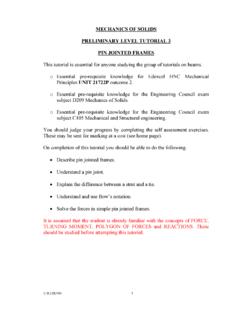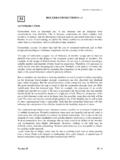Transcription of EDEXCEL NATIONAL CERTIFICATE/DIPLOMA …
1 EDEXCEL NATIONAL CERTIFICATE/DIPLOMA . MECHANICAL PRINCIPLES. OUTCOME 1 ENGINEERING STRUCTURES. TUTORIAL 3 - SHEAR force AND BENDING MOMENTS. 1 ENGINEERING STRUCTURES. TUTORIAL 1. Loading systems: engineering structures subjected to concurrent and non-concurrent external force systems, conditions for external equilibrium, determination of support reactions by graphical and/or analytical methods TUTORIAL 2. Pin-jointed. framed structures: classification of members, conditions for internal equilibrium, determination of magnitude and nature of the primary forces in the members by graphical and/or analytical methods TUTORIAL3.
2 Simply supported beams: simply supported beams and simple cantilevers with concentrated and uniformly distributed loads, determination and graphical representation of shear force and bending moment, relationship between shear force and bending moment, determination of magnitude and position of maximum shear force and bending moment, location of points of contra flexure You should judge your progress by completing the self assessment exercises. These may be sent for marking or you may request copies of the solutions at a cost (see home page).
3 On completion of this tutorial you should be able to do the following. Define a beam. Recognise different types of beams. Define and calculate SHEAR force in a beam. Draw SHEAR force Diagrams. Define and calculate BENDING MOMENT in a beam. Draw BENDING MOMENT DIAGRAMS. Determine where the maximum bending moment occurs in a beam. It is assumed that students doing this tutorial already understand the basic principles of moments, shear force and how to calculate the reaction forces for simply supported beams. This information is contained in the preliminary level tutorials.
4 1. 1. REVISION AND INTRODUCTION TO TYPES OF BEAMS AND LOADS. A beam is a structure, which is loaded transversely (sideways). The loads may be point loads or uniformly distributed loads (udl). Figure 1. The beam may be simply supported or built in. Figure 2. Transverse loading causes bending and bending is a very severe form of stressing a structure. The bent beam goes into tension (stretched) on one side and compression on the other. Figure 3. The complete formula that relates bending stress to the various properties of the beam is M E. = = This is derived in tutorial 1 on beams.
5 I y R. POINT LOADS. A point load is shown as a single arrow and acts at a point. UNIFORM LOADS. Uniform loads are shown as a series of arrows and has a value of w N/m. For any given length x metres, the total load is wx Newton and this is assumed to act at the centre of that length. Figure 4. 2. 2. SHEAR force . SHEAR. The forces on a beam produce shearing at all sections along the length. The sign convention for shear force in beams is as shown. The best way is to remember this is that up on the left is positive. Figure 5. Consider the shear force in a section x metres from the end as shown.
6 Figure 6. Only consider the forces to the left of the section. DEFINITION The shear force is the sum of all the force acting to the left of the section. Since the beam is in equilibrium, it must also be the sum of all the forces acting to the right If the beam is cut at this section as shown, a force F must be placed on the end to replace the shear force that was exerted by the material when joined. List all the forces to the left. Remember up is plus. o There is a reaction force Ra up. o There is a uniform load over the length x metres and this is equivalent to a downwards load of wx Newton.
7 O There is a point load F1 acting down. o The total load to the left is F = Ra wx F1. If the result for F is positive (up) then it produces positive shear. 3. SHEAR force DIAGRAMS. A shear force diagram is simply a graph of shear force plotted against x. This is best demonstrated with several worked examples. WORKED EXAMPLE A cantilever carries point loads as shown. Draw the shear force diagram. Figure 7. SOLUTION. Because there are only point loads, we only need to calculate the shear force at the loads and at the wall as the shear force is constant n between the loads.
8 At the left end the shear force suddenly changes from 0 to -500 N. This remains constant up to x = 1 m and the shear force suddenly changes to 1500 N. This is then constant all the way to the wall and it is obvious that the wall must exert an upwards reaction force of 1500 N to balance all the loads on the beam. The diagram looks like this. Figure 8. In the case of uniformly distributed loads, the shear force increases proportional to length. If the is w N/m then the shear force increases by w Newton for every metre length. 4. WORKED EXAMPLE A simple cantilever beam is loaded as shown in the diagram.
9 Draw the shear force diagram. Figure For any value of x the total downwards load will be wx Newton. SOLUTION. The shear force x metres from the left end is wx = 50 x x=0 F= 50 x 0 = 0. x=1 F= 50 x 1 = 50 down so -50 N. x=2 F= 50 x 2 = 100 down so -100 N. x=3 F =50 x 3 = 150 down so -150 N. x=4 F = 50 x 4 = 200 down so -200 N. x=5 F= 50 x 5 = 250 down so -250 N. Figure 5. WORKED EXAMPLE Draw the shear force diagram for the cantilever beam shown. Figure 11. SOLUTION. Sum the forces to the left of each metre intervals is enough to pot a graph.
10 At x = 0 the shear force goes down 200 N. At x = 1 the totals force to the left is 200 down and 40 x 1 = 40 N down giving a total of - 240 N. Completing the calculations gives the table of results. X 0 1 2 3 4 5. SF -200 -240 -280 -320 -360 -400. The diagrams are like this Figure 12. 6. SELF ASSESSMENT EXERCISE Draw the shear force diagram for the cases below and determine the greatest shear (Answer -300 N). Figure 13. (Answer -540 N). Figure 14. 7. WORKED EXAMPLE Draw the shear force diagram for the simply supported beam shown. Figure 15.
















